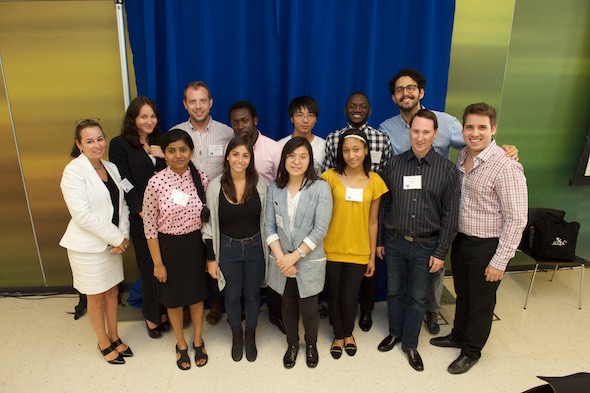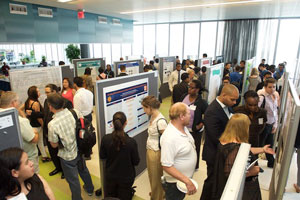
Thirteen Borough of Manhattan Community College students took part in the 2015 CUNY Research Scholars Program symposium held July 22 at John Jay College of Criminal Justice (CUNY).

The CUNY Research Scholars Program (CRSP) funds one-year research scholarships for associate degree-seeking students at CUNY community colleges as well as students from three CUNY comprehensive schools. Each student receives a $5,000 stipend and conducts research under the supervision of a BMCC faculty mentor.
The poster presentations serve as the culminating showcase event for students who completed their research.
The apprentice model-based experience offers a stepping-stone to a future career in Science, Technology, Engineering and Math(STEM) research, said Helene Bach PhD, Director of Research at BMCC.
“Students come to me with a desire to do research outside the classroom,” she added. “My goal is to match them with faculty who guide their projects.”
That day at the symposium, BMCC students stood by their posters in the John Jay College dining hall where they pitched, explained, and in some cases, defended their findings to fellow research students and faculty from other CUNY schools. The BMCC posters reflected lab research that varied from the bioactivity of South African medicinal plants to a study of sensory substitution for transcoding 3D contents to blind people.
A love of science

Among the BMCC presenting scholars was science major Molly Caperna who had also been chosen to represent the college with an oral presentation that afternoon. Caperna’s research focused on the neurological disorder Huntington’s disease.
Caperna arrived at BMCC in 2013. She had started her college career in 2010 at SUNY Old Westbury where she took classes in government and world affairs. During her second semester at SUNY, she took a psychology course, which sparked a deeper interest in the mechanics of the human brain.
She was also beginning to crave knowledge surrounding the human body on its most basic cellular level. In her final semester at SUNY, she took a class in Neuroscience where she says she “fell for Huntington’s disease.”
“By the time I left Old Westbury, I knew I wanted to become a doctor,” said Caperna, who two years later enrolled at BMCC and took a class with Professor Jane M. Tezapsidis. Caperna said she found Prof. Tezapsidis to be “really inspiring as a woman in science.”
Huntington’s Disease

By then, Caperna had been doing her own research on Huntington’s disease, but she knew very little about how to work with cell cultures and lab research.
Huntington’s disease results from an abnormal accumulation, or clumping, of the Htt (Huntington) protein within the brain. Over time, this leads to cell death and the eventual disintegration of all bodily functions.
Caperna and her mentor Jane Johnston Tezapsidis set out to test the effects of brain derived neurotrophic factor (BDNF) on dying neurons in a culture dish.
“In our model study system, SH-SY5Y cells are exposed to stress through serum withdrawal. We have shown that the expression of the Heat Shock Protein A (HSPA5/GRP-78) increases in culture as measured using immunocytochemistry, “Caperna and Tezapsidis wrote in their study summary
Caperna explained that one of the ultimate hopes of her research is to learn how cells can be treated to prevent the clumping of protein inclusions.
After her oral presentation at John Jay College, Caperna said BMCC had in many ways saved her academic life. “I learned a lot about myself, and most especially how to come out of my shell,” she said.
Research adds value to BMCC experience
Bach says lab research is a high-impact activity that’s been shown to increase student recruitment and retention in STEM majors.
“Much of the research that BMCC students are conducting is graduate level work,” said Bach. “The CUNY Research Scholars Program is a huge stepping stone to their future careers in STEM.”
The other BMCC research scholar and professor collaborations presented during the Research Scholar Symposium included:
Ricardo dos Santos Almeida Nunes with Professor Kathleen E. Saavik Ford; “Searching for Gaps in AGN Disks Using SDSS spectra.”
Md Emran Masud and Saidakbar Irkakhujaev with Professor Abel Navarro; “Bioremediation of Phenolic Compounds using Puerto Rican Marine Algae.
Huang Zou with Professor Hao Tang; “Transcoding 3D Contents to Blind People.”
Drew Ballard with Professor Lalitha Jayant; “Identification and Characterization of Edndogenous Plasmids from Marine Bacteria Isolated rom the Sea Urchin Lytechinus varieagatus.”
Leor Franco with Professor Matthew Geddis; “Spatial and Temporal Distribution of Neurons During Neurogenesis in Regenerating Planaria.”
Abdoul Kone with Professor Shanti Rywkin; “Confocal Raman Microscopy (CRM) Studies of the Interaction of Phenothiazine dyes with MCF-7 Breast Cancer Cells.”
Madhyama Vijayalakshman and Imani Garriga with Professor Alexander Gosslau and Professor Adolfina Koroch; “Anti-oxidative effects of natural extracts of traditional medicinal plants: Acalypha indica and Lippia multiflora.”
Jeff Hedrick and Mark Collison with Professor Alexander Gosslau and Professor Adolfina Koroch; “Analysis of the bioactivity two South African medicinal plants; “Honeybush (Cyclopia maculata) and Rooibos (Aspalathus linearis).”
MinYeong Hong with Professor Abel Navarro; “Batch Absorption of Heavy Metals Onto Chai Tea Residues for the Bioremediation of Contaminated Solutions.”
Guillermo Herrera with Professor Shalva Tsiklauri; “Making Electricity by Using Solar Radiation.”
STORY HIGHLIGHTS
- BMCC Students are part of CUNY Research Scholars Program
- BMCC student Molly Caperna focused on Huntington’s Disease
- Other students did graduate level work

